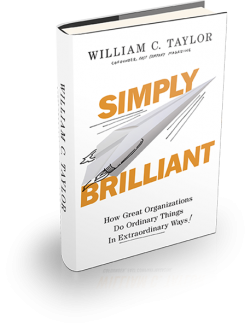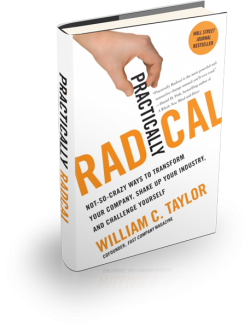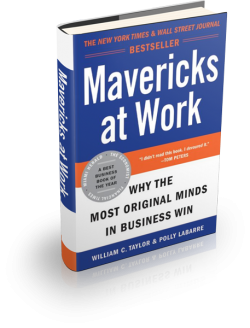When it comes to strategy, one way to meet radically new expectations in your industry is to draw from the impressive and surprising strategies that are being used in other industries. Why can’t interacting with an insurance company be as responsive and transparent as interacting with Uber? Why can’t checking into a hospital be as seamless as checking into a hotel? These are the sorts of questions that more and more customers are asking, and the questions that a winning business strategy must answer. You won’t find those answers if you limit your strategic vision to what other companies in your field are doing. Remember, your competitors aren’t always who you think they are.
Author Archive
HBR: Persuading Your Team to Embrace Change

How do leaders persuade people to do things they would rather not do? The author outlines two very different persuasive techniques based on social science: the “foot-in-the-door” technique and the “door-in-the-face” technique. Each of these techniques can work in the right situation, although neither of them translates perfectly from the ivory-tower world of social-science research into the messy realities of organizational life. But both techniques can help leaders reflect the hard work of making big change, and what is required to get beyond what management theorists like to call “active inertia” — the tendency for people and organizations to seek comfort in the old ways of doing things, even (or especially) when the world around them is changing dramatically.
Fast Company: Four lessons on innovation from the most creative team in baseball

Opening Day of the baseball season offers the chance to reflect on the arrival of spring, the childhood pleasures of skipping school for the ballpark—and, for people like me, who think about creativity and innovation, how hard it can be to change an institution that is in desperate need of reimagination and renewal. Most everyone agrees, as a recent Sports Illustrated analysis made clear, that Major League Baseball games take too long and move too slowly, that the so-called unwritten rules of on-field behavior wind up ruling out fun and spontaneity, and that the rise of analytics has replaced human drama with algorithmic tyranny. No wonder MLB now ranks behind the NFL and the NBA in terms of popularity and star power.
Fast Company: How one humble Main Street retailer beat COVID-19—and Amazon
A crisis, the old bromide goes, is a terrible thing to waste. One way not to waste the brutal crisis we’ve experienced over the past year is to learn from organizations that have thrived while their peers have struggled. What did they see that others didn’t see? What did they promise that other couldn’t promise? What did they do that other wouldn’t do?
HBR: How to Stay Optimistic (When Everything Is Awful)
These are trying times for optimists. Covid deaths remain tragically high. Job growth remains stubbornly low. So many of our colleagues and kids are feeling stressed, exhausted, angry — “hitting the pandemic wall.” No wonder a recent front-page article in the Wall Street Journal, which has chronicled the Covid-driven struggles of companies and universities, highlighted a crisis at a different kind of organization — Optimist International, a 110-year-old club with chapters around the world. Membership is now at 60,000, down from a high of 190,000, although club leaders remain true to their guiding spirit. “When you hit rock bottom, the only direction you can go is up,” said one chapter head, who declared she was “getting my optimistic groove back.”
HBR: The Leadership and Artistry of Tony Hsieh
Tony Hsieh, the former CEO of Zappos and a legendary internet entrepreneur and management thinker, has died at age 46. His passing has inspired an outpouring of affection and remembrances, and there is an understandable rush to evaluate the impact of his leadership. But to do so for Tony requires thinking about him as an artist and not just a long-serving CEO, as someone driven by big ideas, experimentation, and grand passions rather than just business plans and stock-price targets. As with so many artists, the things that made Tony so easy to admire were brilliant and messy at the same time, which is what makes his legacy so rich and his lessons so valuable.
HBR: To Solve Big Problems, Look for Small Wins
It is tempting, during a crisis as severe as the Covid-19 pandemic, for leaders to respond to big problems with bold moves — a radical strategy to reinvent a struggling business, a long-term shift to virtual teams and long-distance collaboration. Indeed, so much of the expert commentary on Covid-19 argues, as did a recent white paper from McKinsey & Company, that we are on the brink of a “next normal” that will “witness a dramatic restructuring of the economic and social order in which business and society have traditionally operated.”
HBR: How Bad Times Bring Out the Best in People
It’s easy to look around and see how the Covid-19 crisis has brought out the worst in some people — from hoarding thousands of bottles of hand sanitizer to crowding bars and restaurants despite public-health guidelines. But such irresponsible behavior, I believe, is more the exception than the rule. Time and again, individuals and communities have demonstrated that the worst situations tend to bring out the best in people and the organizations to which they belong. In every moment of darkness, it seems, there are countless moments of light — small gestures of compassion and connection that allow people to show who they are, how they want to live, and what matters to them.
HBR: Don’t Let Negativity Sink Your Organization
Every so often, you encounter academic research that snaps into place a whole bunch of tensions, issues, and problems that you’ve noticed but haven’t been able to understand. That happened to me when I read a new book called The Power of Bad: How the Negativity Effect Rules Us and How We Can Rule It. The authors of the book, renowned research psychologist Roy F. Baumeister and award-winning journalist John Tierney, offer lessons from social science about life, love, parenting, even politics.



